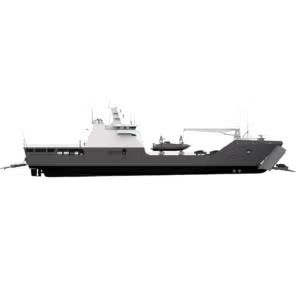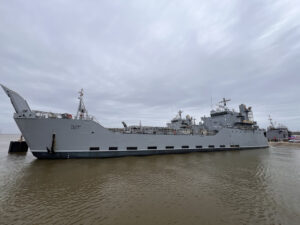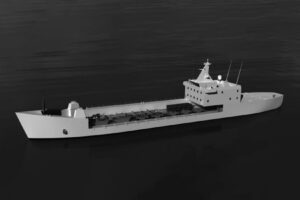Light Amphibious Warship (LAW)
-
 Navy/USMC
Navy/USMCNavy Expects First LSM Hull Ready By 2029
The Navy plans for the new Medium Landing Ship (LSM), based on the Dutch Damen Naval design, to be built at multiple shipyards and have the first hull delivered by […]
Tagged in: -
 Navy/USMC
Navy/USMCNavy Picks Dutch Design For LSM Over Bollinger
Navy leadership on Dec. 5 announced it selected a ship design from Dutch shipbuilder Damen Naval to become the basis for the latest iteration of the Medium Landing Ship (LSM). […]
Tagged in: -
 Navy/USMC
Navy/USMCBollinger Wins First Contract For First Landing Ship Medium
The Navy on Friday awarded Bollinger Shipyards a $9.5 million contract to start procuring long lead time material and related engineering and design activities for the initial Block One Landing […]
Tagged in: -
 Navy/USMC
Navy/USMCNavy Steps Closer To LSM Block I As It Procures Bollinger And Damen Data Rights
The Navy moved another step closer to awarding its first revamped Medium Landing Ship (LSM) contract with an award to Bollinger Shipyard Lockport LLC for the data rights to build […]
Tagged in: -
 Navy/USMC
Navy/USMCNavy Begins Looking Into Vessel Construction Manager For First LSM Amphib
Naval Sea Systems Command (NAVSEA) recently issued a notice starting the process to find a Vessel Construction Manager (VCM) to build the first Medium Landing Ship (LSM), Block 1. According […]
Tagged in: -
 Navy/USMC
Navy/USMCAuthorizers Support New LSM Plan, Impose Vessel Construction Manager Strategy
The newly released House and Senate Armed Services Committee’s FY 2026 defense authorization bills both support the Navy’s latest strategy to move forward with a non-developmental design for the Medium […]
Tagged in: -
 Uncategorized
UncategorizedMarine Corps Confirms Testing With Army Vessel That Will Be Basis Of New First Draft Of LSM
A Marine Corps unit that the Pentagon plans to ultimately deploy with the Landing Ship Medium (LSM) confirmed to reporters it has tested with an Army watercraft set to be […]
Tagged in: -
 Navy/USMC
Navy/USMCMarine Corps Outlines LSM Future: First Within Five Years, Sharing Second Test Ship With Australia, Hybrid Crewing T-EPFs
Navy and Marine Corps officials on Wednesday outlined the next steps in the Landing Ship Medium (LSM) program and bridging solutions until it is ready as they redirect away from […]
-
 Navy/USMC
Navy/USMCNavy To Award Bollinger First LSM Amphib Hull Based On Israeli Ship
The Navy earlier this month posted a presolicitation notice that it intends to issue Bollinger Shipyards Lockport LLC a sole-source contract for the first Landing Ship Medium (LSM) based on […]
Tagged in: -
 Navy/USMC
Navy/USMCSenate’s LSM Amphib Limits Win In Final NDAA
The Senate’s version on limitations for the future Medium Landing Ship (LSM) for the Navy and Marine Corps won out in the final FY 2025 defense authorization bill, requiring the […]
